Do you enjoy walking through vast forestlands and seeing wildlife birds in their natural habitat? Then, Kentucky should be at the top of your list of must-see states.
This Bluegrass State is made up of 48% forestland. It also boasts 45 major lakes and reservoirs and nearly 3,000 miles of rivers.
Just imagine the diversity of the birds as they swoop, soar, and glide overhead. There are around 375 species of stunning birds in Kentucky in various brilliant colors and hues. Nearly 150 of them regularly breed in the southeastern state.
We rounded up 30 of these amazing types of birds. Keep a lookout for these and more on your next visit to the Bluegrass State!
Let’s dive in.
Red Birds in Kentucky
Northern Cardinal
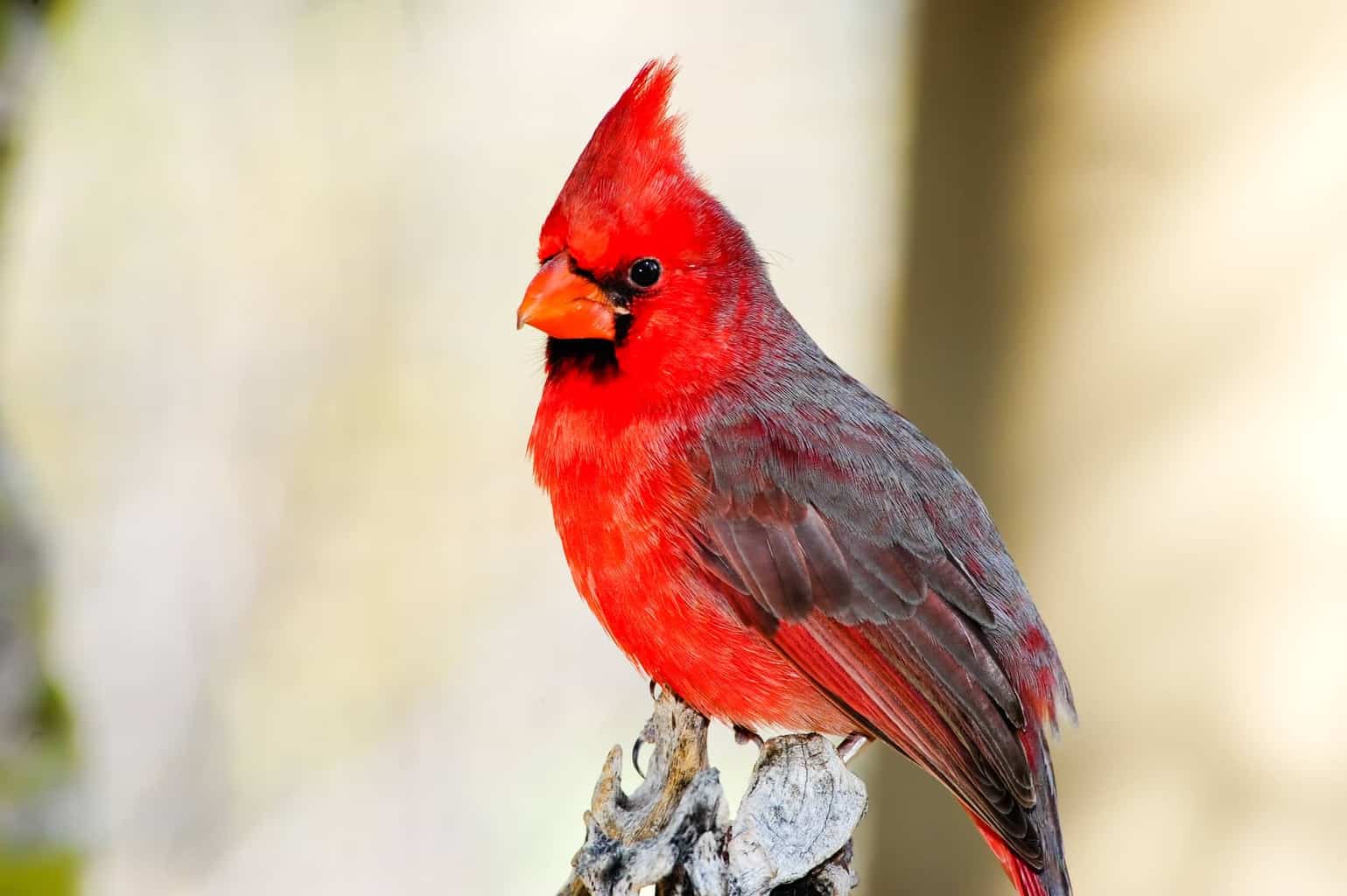
- Scientific Name: Cardinalis cardinalis
- Length: 8–9 in
- Weight: 1.5 oz
- Wingspan: 10–12 in
Additional Information:
The Northern Cardinal is a medium-sized songbird that’s a common backyard visitor. These birds love snacking on corn, peanuts, and sunflower seeds with their short, thick bills.
Male Northern Cardinals are covered in vivid red plumage. They have black throats and masks.
Females, on the other hand, aren’t as brightly colored. Instead, they’re paler with orange-brown tinges on their wings and tails.
Summer Tanager
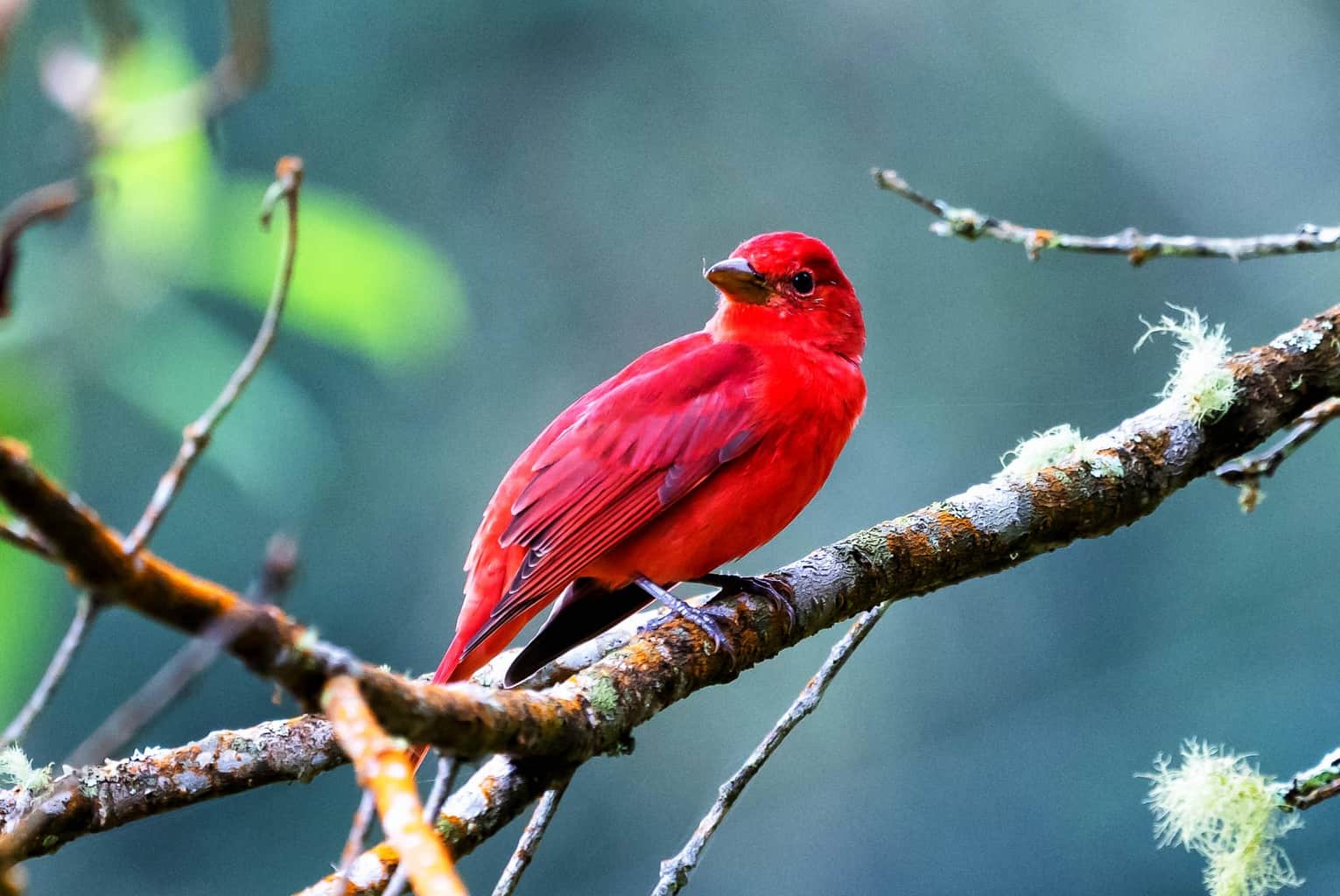
- Scientific Name: Piranga rubra
- Length: 7.5 – 8 in
- Weight: 1 – 1.5 oz
- Wingspan: 11 – 12 in
Additional Information:
Summer Tanagers are known for catching wasps and bees by beating them against the branches. Their wing strokes are quick and rapid, resulting in a swift, direct flight.
Adult male Summer Tanagers are deep red all over. In fact, they’re the only species in North America that are entirely red.
Females have muted olive-yellow underparts and pale yellow upper parts. Both males and females have large whitish-grey bills, legs, and feet.
Vermilion Flycatcher
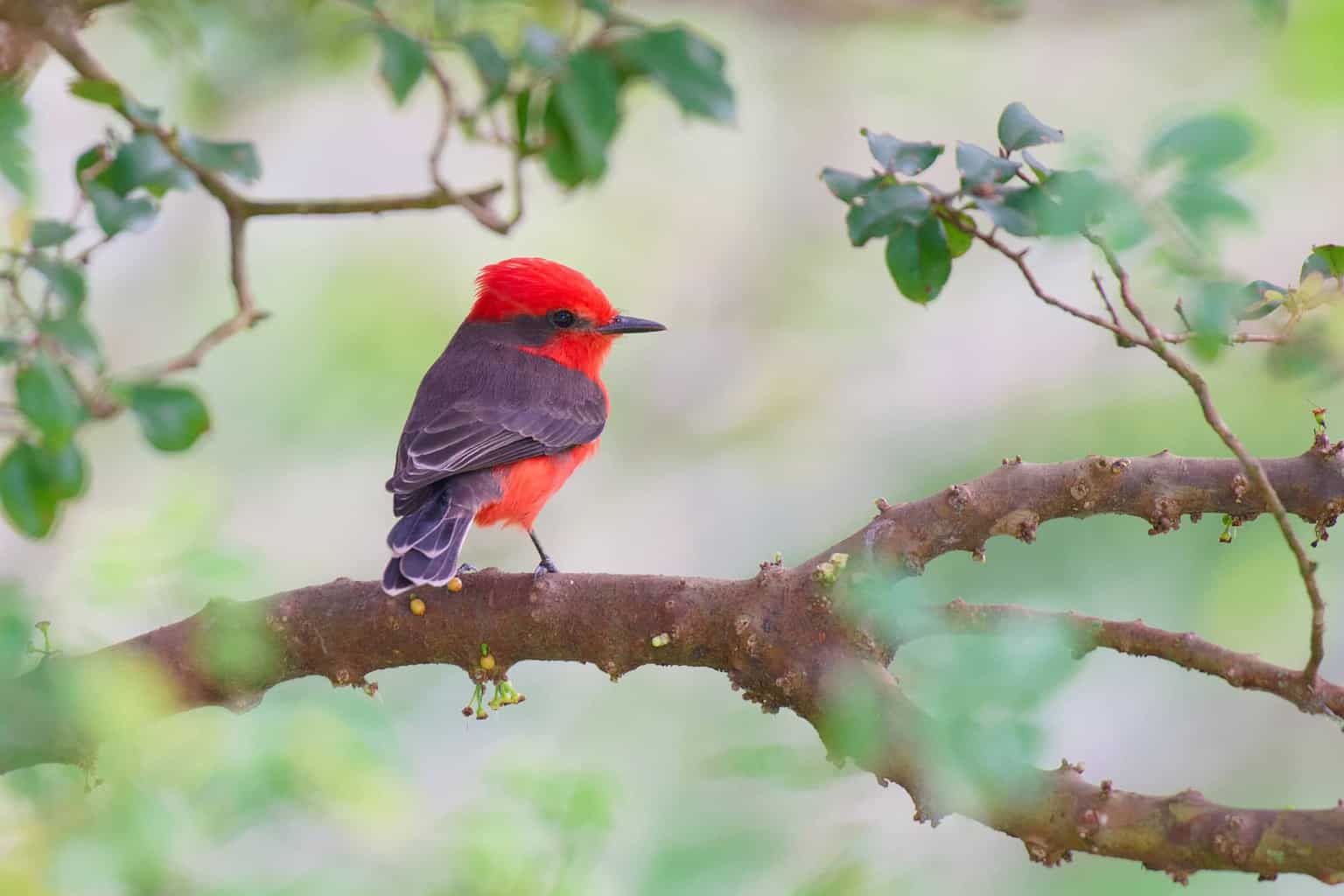
- Scientific Name: Pyrocephalus rubinus
- Length: 6 – 6.5 in
- Weight: 0.5 – 1 oz
- Wingspan: 12 – 13 in
Additional Information:
Vermilion Flycatchers are easily distinguished by their shallow wing beats. They’re known to hover when feeding and catch insects in mid-air.
Males have scarlet-red crowns, necks, and chests. There’s a thick, black line that runs from around their eyes to their backs and wings all the way to the tails.
Females have creamy grey underparts that turn a pale red shade on their lower bellies and vents. Their caps and wings are a darker grey with tinges of black.
Red-Headed Woodpecker
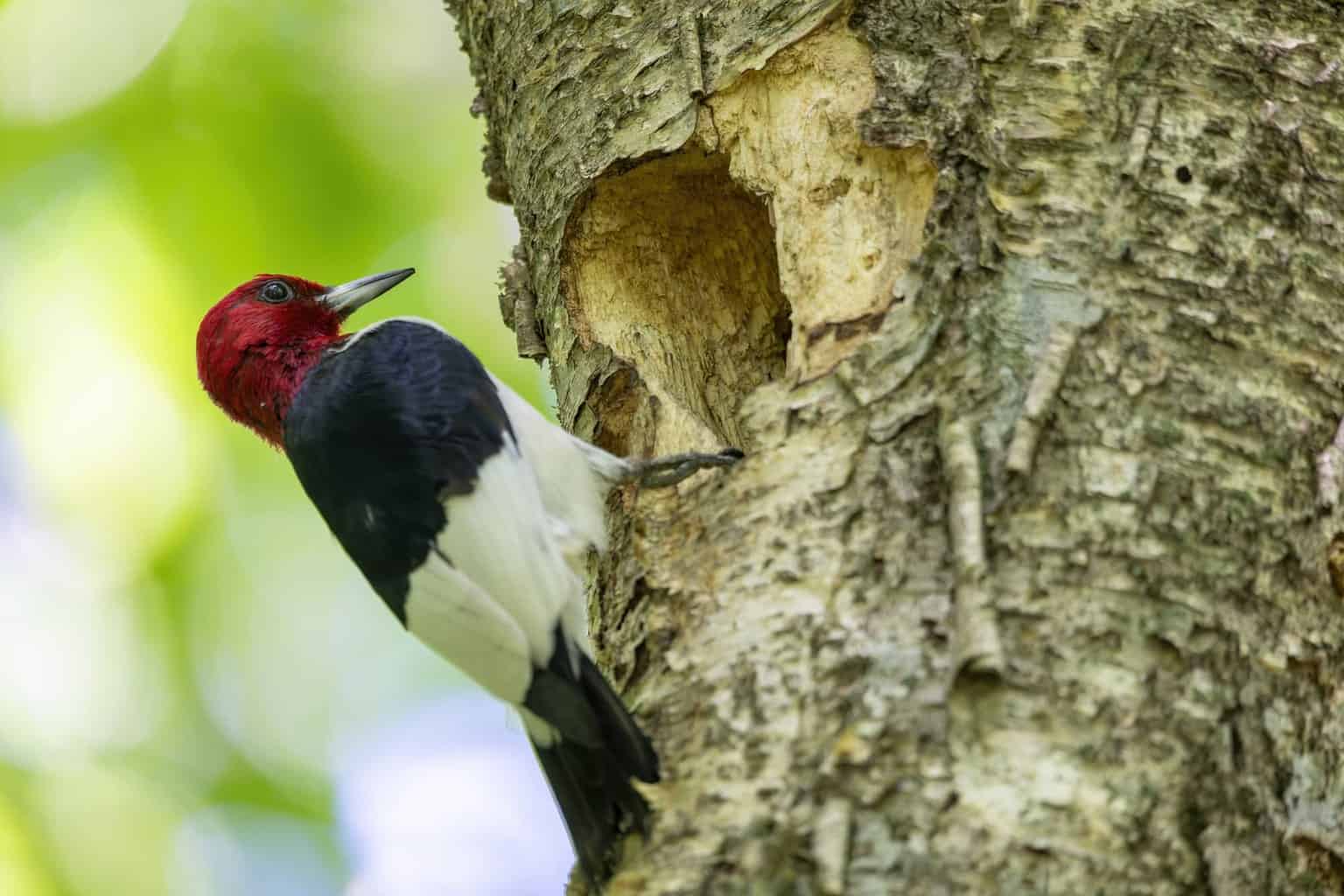
- Scientific Name: Melanerpes erythrocephalus
- Length: 8.5 – 9 in
- Weight: 2 – 2.5 oz
- Wingspan: 16 – 18 in
Additional Information:
Red-Headed Woodpeckers sally from their perches to catch insects before returning back. These Kentucky nesters are also fond of seeds, nuts, and fruit.
Their bold patterns have earned them the nickname “the flying checkerboard.” These colorful birds are sexually monomorphic, which means both sexes look the same.
Both males and females have vivid crimson heads and throats. Their backs and tails are black, while their underparts are mainly white.
Blue Birds in Kentucky
Eastern Bluebird

- Scientific Name: Sialia sialis
- Length: 7 – 8 in
- Weight: 1 – 2 oz
- Wingspan: 11.5 – 13 in
Additional Information:
Eastern Bluebirds are among the most common birds in Kentucky. They’re usually found in open fields, parks, and golf courses.
These cute birds are easy to identify. Males are vivid blue with brick-red chests and throats.
Females are dull blue with dark grey wings and caps. Their underparts are rust-brown and white.
Painted Bunting

- Scientific Name: Passerina ciris
- Length: 5 – 5.5 in
- Weight: 0.5 – 1 oz
- Wingspan: 8 – 8.5 in
Additional Information:
Painted Buntings produce several broods with the same partner each mating season. They usually set up their nests in brushy areas and woodland edges.
Painted Buntings are among the most vibrant birds of all US-breeding birds. They have a rich mix of blues, greens, yellows, and reds.
Females are just as colorful. Yet, their blue isn’t as bright as the other colors.
Blue Jay

- Scientific Name: Cyanocitta cristata
- Length: 11 – 11.5 in
- Weight: 3 – 4 oz
- Wingspan: 16 – 18 in
Additional Information:
A Blue Jay’s favorite nesting spots include farmlands, evergreen forests, and even the suburbs. This adorable bird is widespread throughout the whole state.
The first thing you’ll notice when you spot a Blue Jay is its bluish-purple crown. The same color extends to their foreheads.
Blue Jays have white plumage on their underparts with a slight streaking of grey. Their backs are a deep blue, and their wings have light blue feathers, covered with fine black stripes.
Tree Swallow
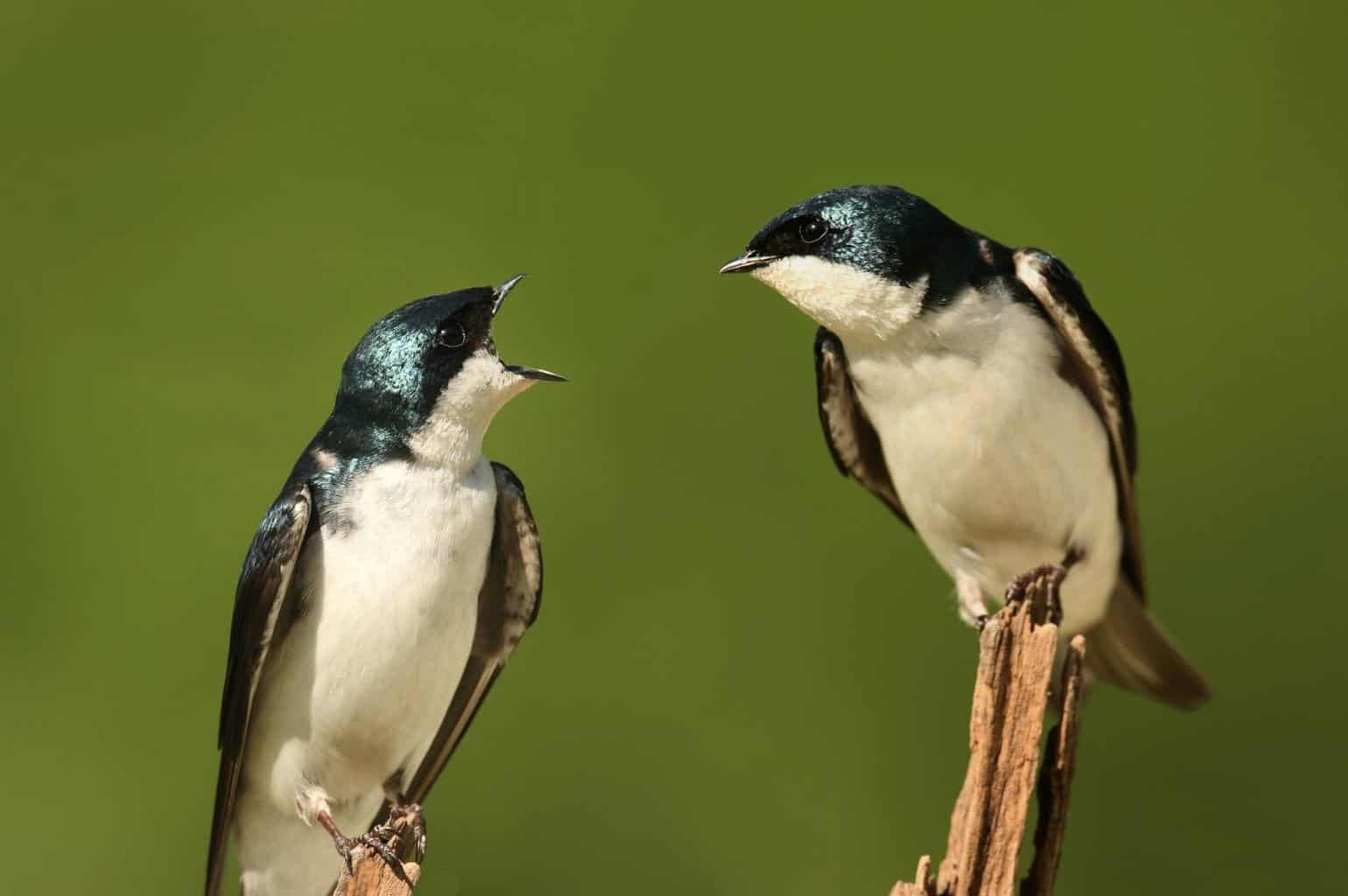
- Scientific Name: Tachycineta bicolor
- Length: 5 – 6 in
- Weight: 0.5 – 1 oz
- Wingspan: 12 – 12.5 in
Additional Information:
Tree Swallows are known to nest in open areas near lakes or rivers. They catch insects in mid-flight, as well as forage on the ground, looking for insects.
These medium-sized birds are covered in iridescent blue-green plumage. Their underparts are a pale grey with tints of white.
Females have more grey plumage with brown underparts. They also have a faint grey-brown band running across their chests.
Green Birds in Kentucky
Kentucky Warbler

- Scientific Name: Geothlypis formosa
- Length: 5 – 5.5 in
- Weight: 0.5 – 1 oz
- Wingspan: 8 – 8.5 in
Additional Information:
Kentucky Warblers forage on the ground by scratching it and searching in the leaf litter. Their diet includes spiders, caterpillars, and grubs.
Males have bright olive-green upper parts. Their underparts have more of a yellowish tint.
Females are a less vivid shade of green and yellow on their upper parts. Their caps and underparts are mottled greys or black.
Green Heron

- Scientific Name: Butorides virescens
- Length: 18 – 22 in
- Weight: 9 – 11 oz
- Wingspan: 25 – 26 in
Additional Information:
Green Herons are beautiful in flight. Their square tails spread out like a fan and their broad, pointed wings arch gracefully as they glide in the air.
Both males and females have similar coloring. Their upper parts are greyish-green, and they have a dark green cap with a small crest.
The Green Heron’s throat is white and rufous. The pale color contrasts with the various shades of brown on their heads and upper chest areas.
Ruby-Throated Hummingbird
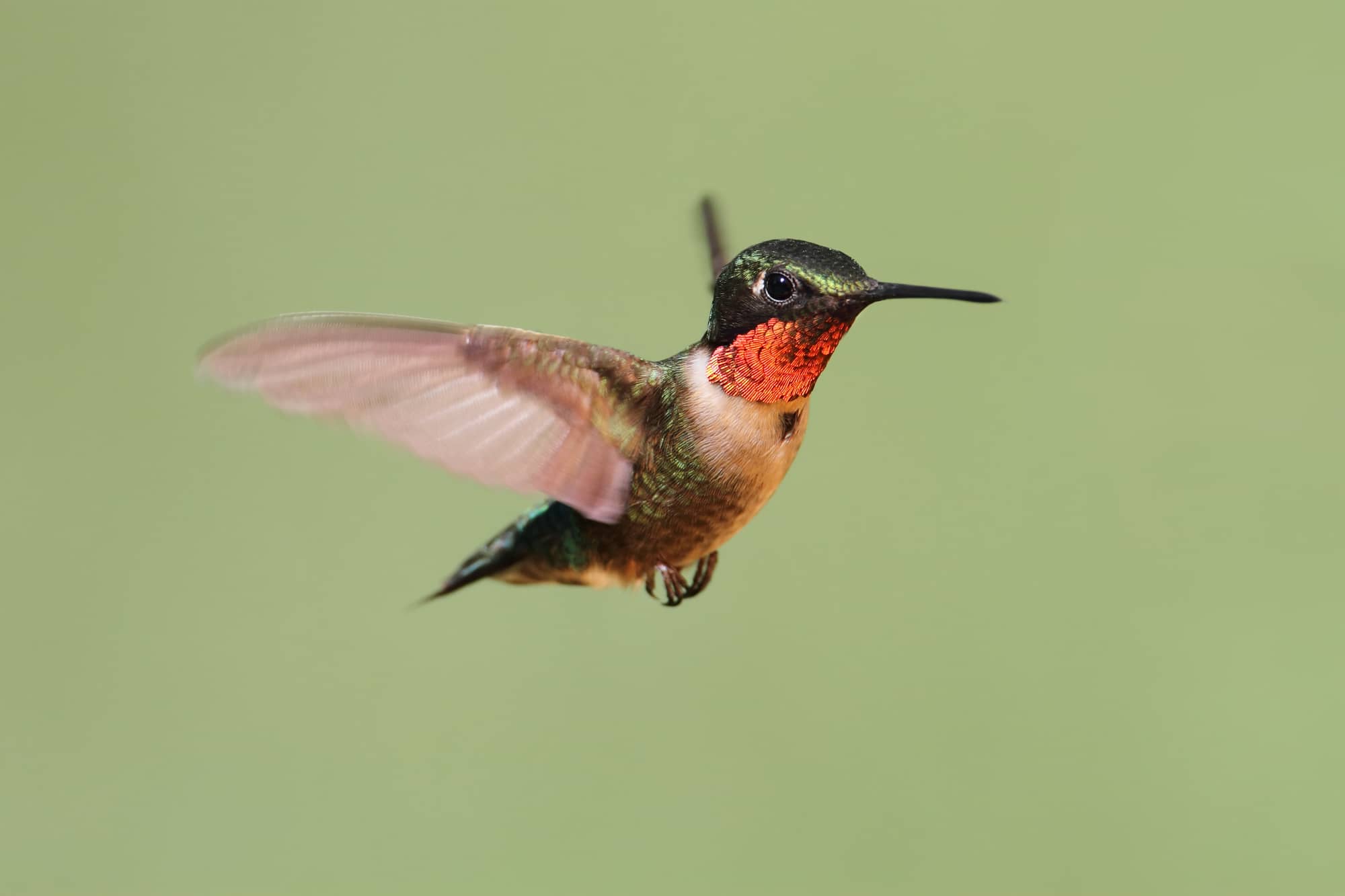
- Scientific Name: Archilochus colubris
- Length: 3 – 4 in
- Weight: 0.1 – 0.5 oz
- Wingspan: 4 – 4.5 in
Additional Information:
Don’t let its cuteness fool you. The Ruby-throated Hummingbird is one powerful bird with rapid wing beats and the ability to fly backward.
Almost everything on this tiny adorable bird is green. The underparts, upper parts, tail, crown, nape, and throat are all iridescent green.
Females are also covered in green plumage. Yet, it’s slightly more lackluster than the plumage of the male.
Mexican Violetear
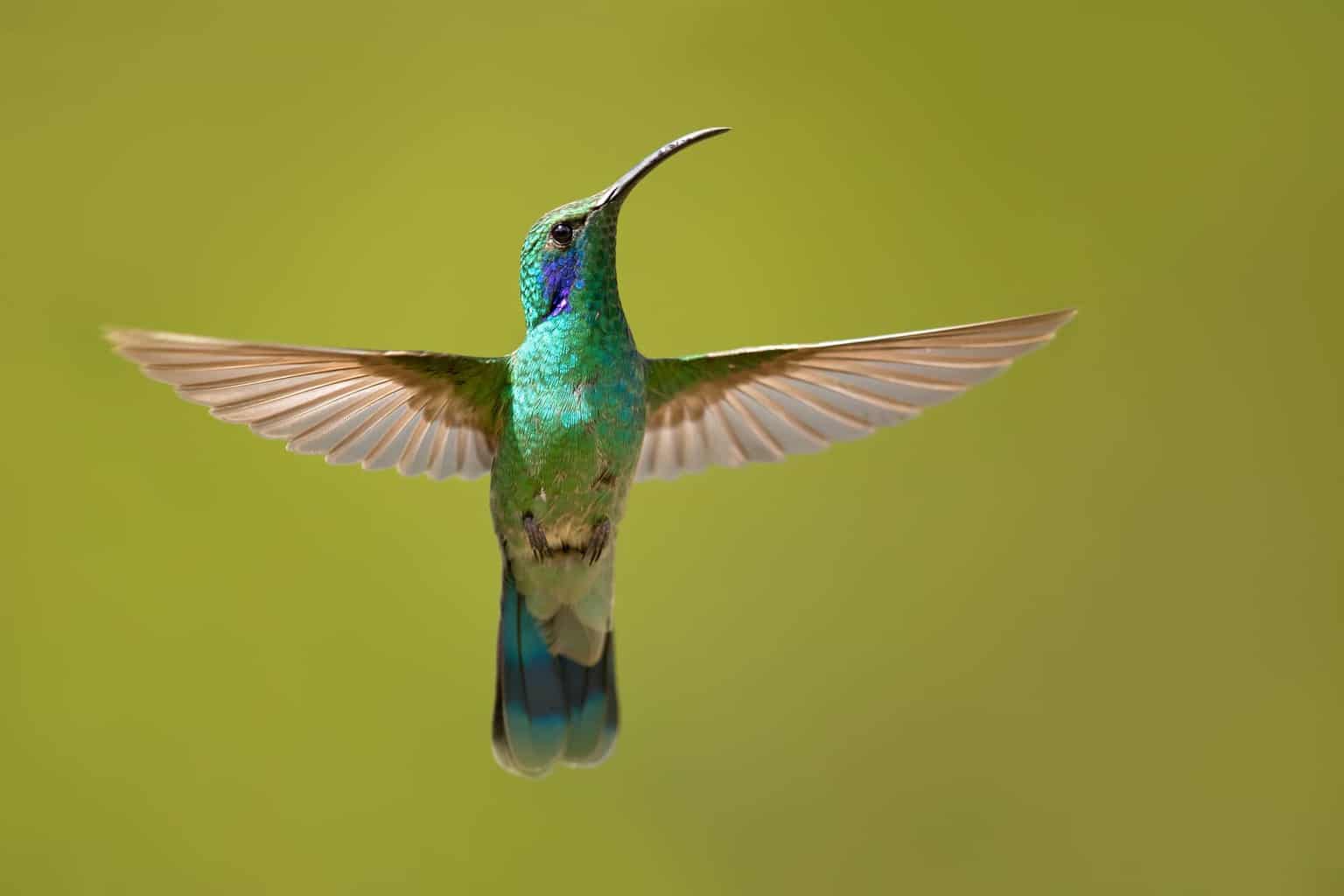
- Scientific Name: Colibri thalassinus
- Length: 4 – 5 in
- Weight: 0.2 – 0.5 oz
- Wingspan: 5 – 6 in
Additional Information:
The Mexican Violetear is a large hummingbird species with a direct and hovering flight pattern. Their preferred habitat is forest clearings, where there are plenty of insects and nectar.
These medium-sized birds have dark metallic green plumage. Their square tail is blue-green with a thick black band.
Females have similar iridescent colors as males. Yet, males are larger and have a more vibrant green on their throats and chest areas.
Orange Birds in Kentucky
Black-Headed Grosbeak
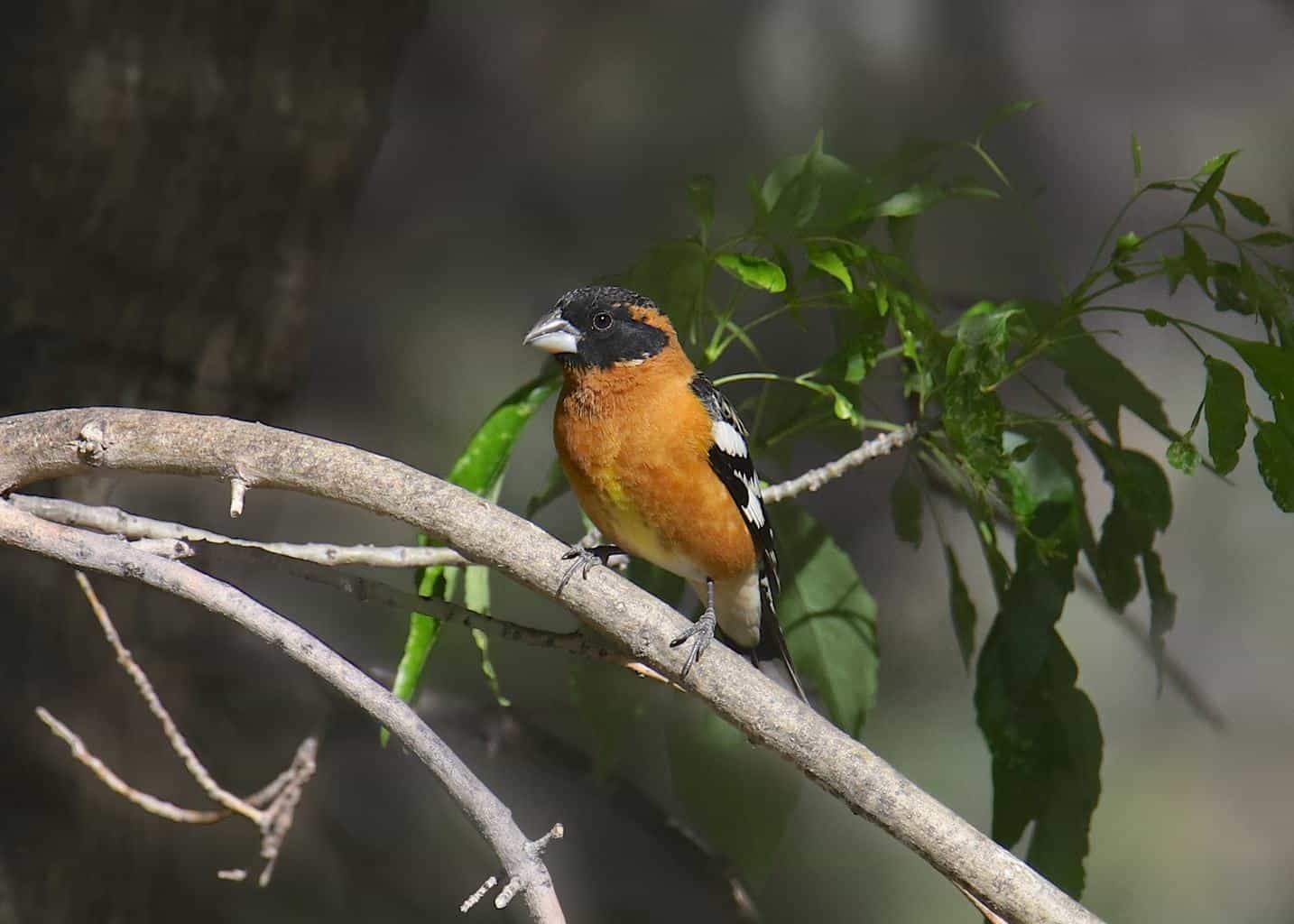
- Scientific Name: Pheucticus melanocephalus
- Length: 6.5 – 8.5 in
- Weight: 1 – 2 oz
- Wingspan: 12 – 13 in
Additional Information:
The Black-headed Grosbeak is stocky and chunky like a wrestler. Its head is large, which makes its neck look small and almost non-existent.
You can easily identify the males by their deep orange color. Their heads are black, while their wings are striped in thick black and white bands with bright yellow underwings.
Females have similar coloring but in more subtle shades. Plus, their heads and necks are brown with thin streaks of black.
Rufous Hummingbird

- Scientific Name: Selasphorus rufus
- Length: 3 – 5 in
- Weight: 0.1 – 0.5 oz
- Wingspan: 4 – 5 in
Additional Information:
We adore all hummingbirds, and Rufous Hummingbirds are no exception. Their fan-shaped tails and pointed wings allow them to hover in mid-air when feeding.
Their primary color is rufous, or orange-red plumage. In addition, they have iridescent green feathers on their upper parts.
Females have the same orange coloring, but only on their sides and below their tails. Their chests and bellies are white, while their upper parts are also iridescent green like the males.
Varied Thrush
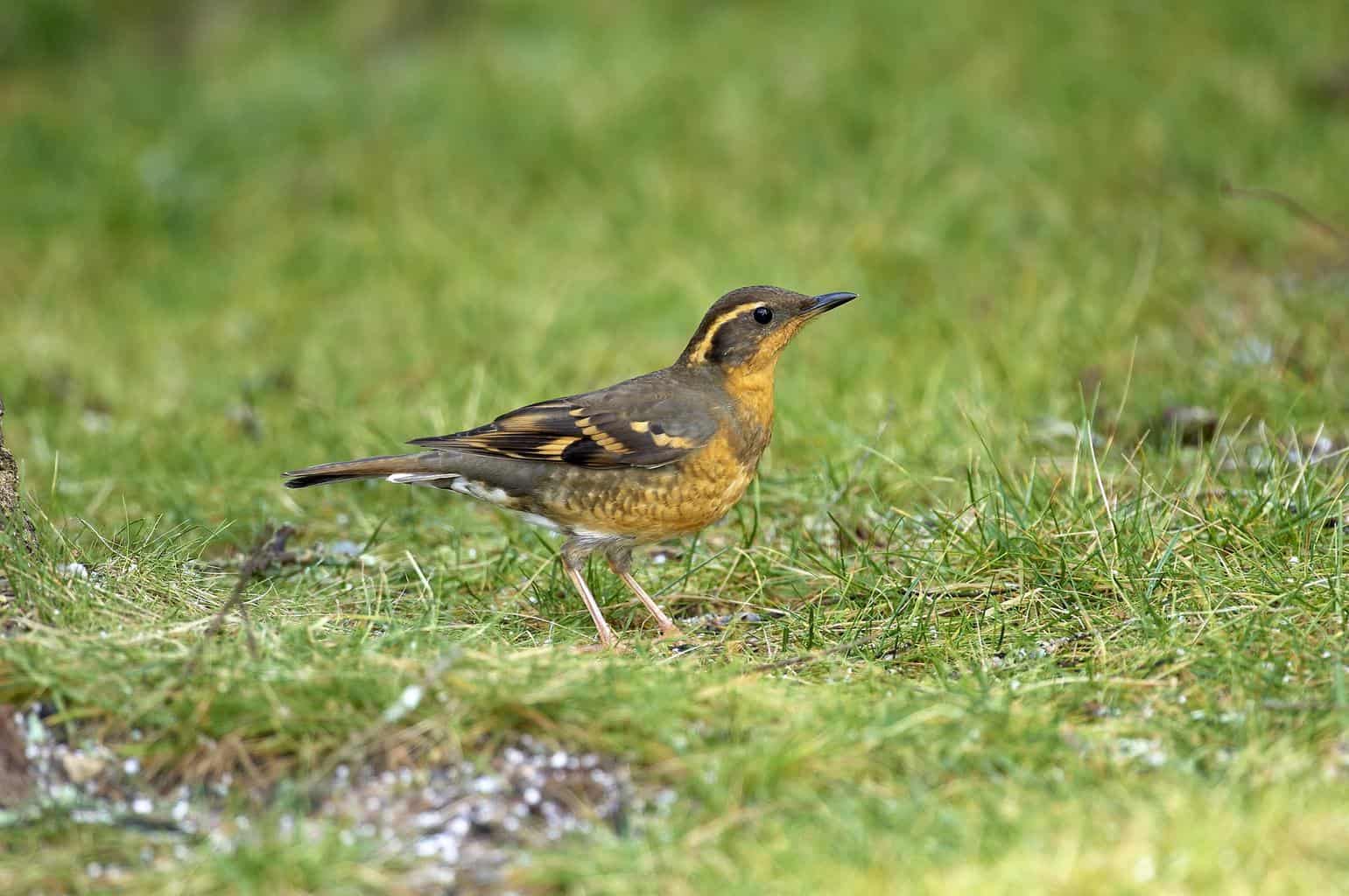
- Scientific Name: Ixoreus naevius
- Length: 5 – 9 in
- Weight: 2 – 3 oz
- Wingspan: 14 – 16 in
Additional Information:
Like other thrushes, the Varied Thrush forages on the ground for berries and insects. Its preferred habitats are usually dense deciduous or coniferous forests near bodies of water.
Males are large with orange-red throats, sides, and eyebrows. They have a white belly with a black upper breast band.
Females have similar color patterns. Yet, you can tell between the two sexes by the females’ more subdued plumage.
Bullock’s Oriole

- Scientific Name: Icterus bullockii
- Length: 7 – 8.5 in
- Weight: 1 – 1.5 oz
- Wingspan: 11 – 12.5 in
Additional Information:
Social and easy to identify, Bullock’s Orioles enjoy nesting in shade trees in suburbs, city parks, and woodlands. If you have a bird feeder, you may find them lounging in your backyard snacking on seeds and sugar water.
Bullock’s Orioles are mostly a rich orange color covering their entire underparts and most of their faces. They have black crowns, tails, and backs.
Both sexes have dark wings with large white streaks. However, females have more yellow hues.
Yellow Birds in Kentucky
American Goldfinch

- Scientific Name: Spinus tristis
- Length: 5 – 8 in
- Weight: 0.5 – 1 oz
- Wingspan: 8.5 – 9 in
Additional Information:
American Goldfinches are late nesters. They start in late June when most songbird species are ending their breeding season.
Males are bright yellow with black caps, wings, and shoulder bars. Their rumps, tails, and covert feathers are white.
Females are a more subdued greenish-yellow. Unlike the males, they have black caps, but they do have the same yellow shoulder bars.
Prairie Warbler

- Scientific Name: Setophaga discolor
- Length: 3 – 5 in
- Weight: 0.1 – 0.5 oz
- Wingspan: 7 – 8 in
Additional Information:
Contrary to their name, these small warblers are rarely found in prairies. Instead, they prefer setting up their nests in pastures, hillsides, and mangrove swamps.
Male Prairies Warblers have vibrant yellow underparts with streaks of black on either side. They also have dark yellow caps and faces.
The females have yellow plumage just like the males, but they’re just not as bright. They’re easily identified by the dark stripes on their cheeks.
Common Yellowthroat
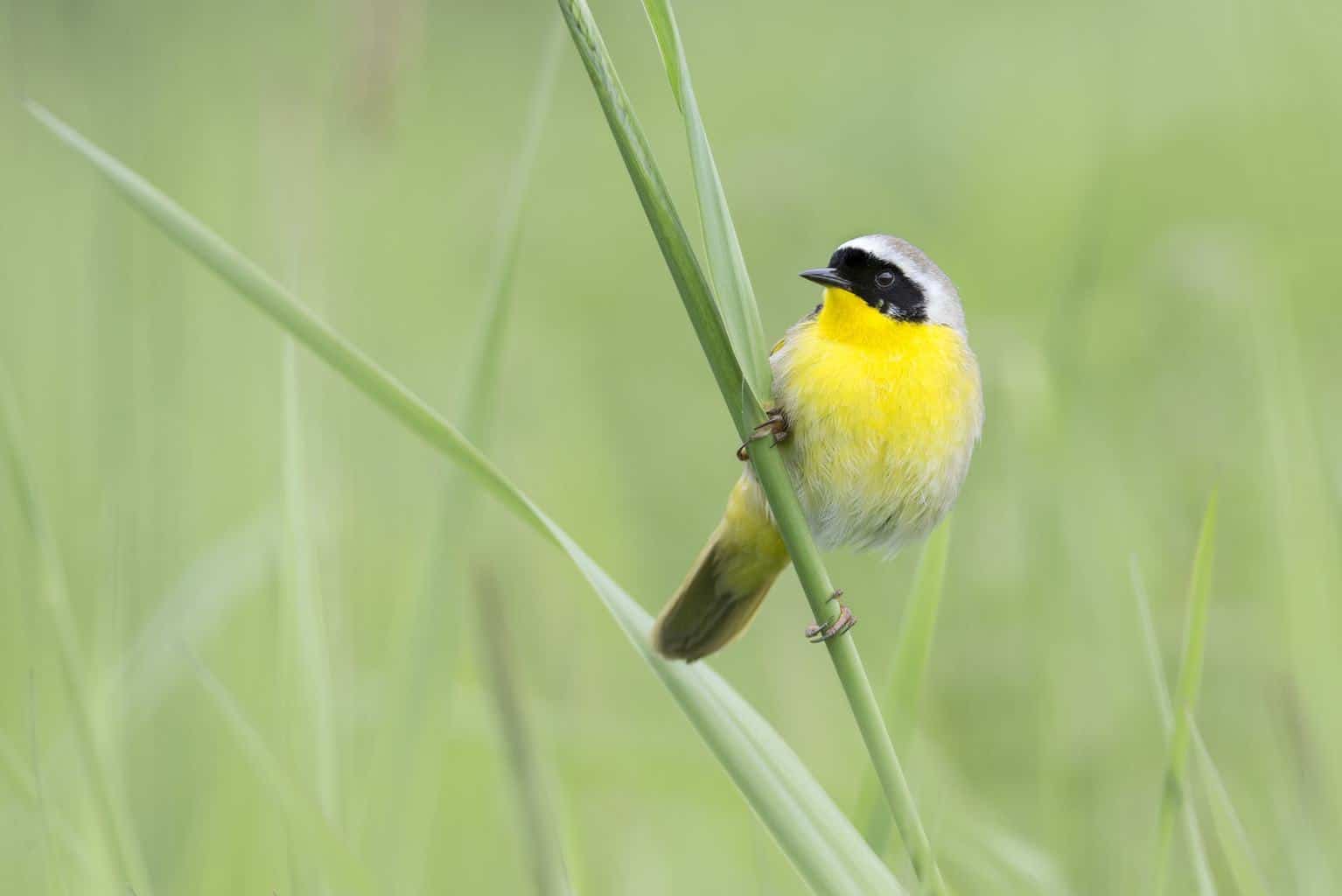
- Scientific Name: Geothlypis trichas
- Length: 5 – 7 in
- Weight: 0.5 – 1 oz
- Wingspan: 8 – 10 in
Additional Information:
While cute and seemingly adorable, the Common Yellowthroat is considered a skulking breed. Its favorite habitats include willow marshes and streams, as well as damp, brushy grasslands.
Male Common Yellowthroats are olive-yellow. Their chests and throats are a bright shade of yellow, while their bellies are a soft shade of grey.
They’re also distinguished by a thick black mask with a white stripe above it. Females have similar coloring, but they don’t have any facial markings.
Northern Parula
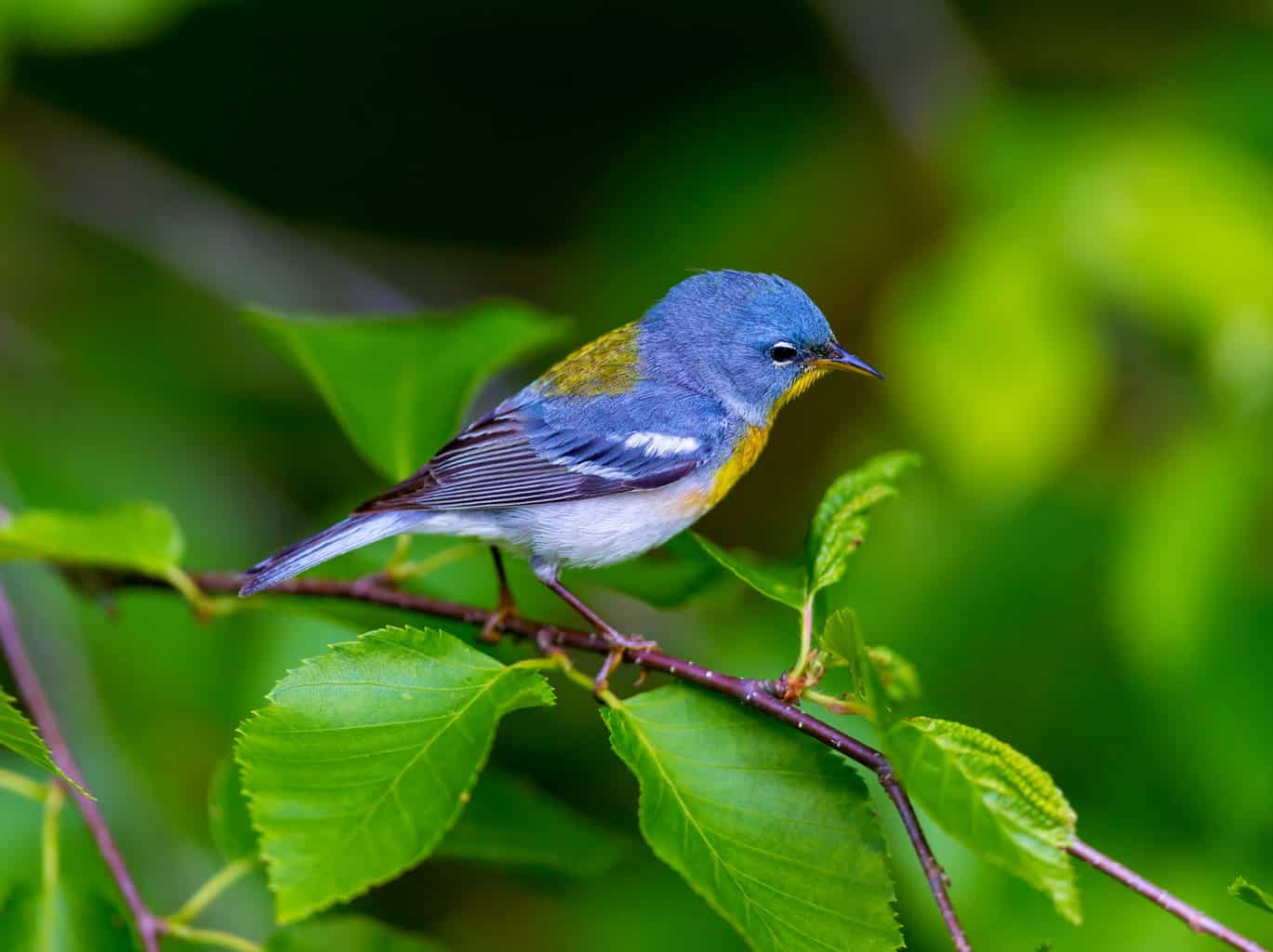
- Scientific Name: Setophaga americana
- Length: 3 – 5 in
- Weight: 0.3 – 1 oz
- Wingspan: 7 – 9 in
Additional Information:
Northern Parulas are breathtaking when they spread their rounded-tip wings and take flight. You can spot them catching insects in mid-air before returning to their resting spots on high branches.
Both males and females have bright yellow throats that make a sharp contrast with their blue-greyish upper parts. Their bellies are white and soft grey.
Males have broad brown and black bands on their chests. In contrast, females lack this upper breast band.
Other Birds To Watch For in Kentucky
Black Birds
Yellow-Billed Loon

- Scientific Name: Gavia adamsii
- Length: 16 – 32 in
- Weight: 190 – 195 oz
- Wingspan: 54 – 60 in
Additional Information:
Yellow-billed Loons spend their time in lakes and ponds with high fish populations. They feed on crustaceans and small fish, which they catch by diving underwater.
These water birds have vivid yellow bills as opposed to common loons, which have grey bills. Still, the majority of their plumage is glossy black.
Both females and males have black upper parts with white spots. Their underparts are white with pale grey markings.
Fish Crow
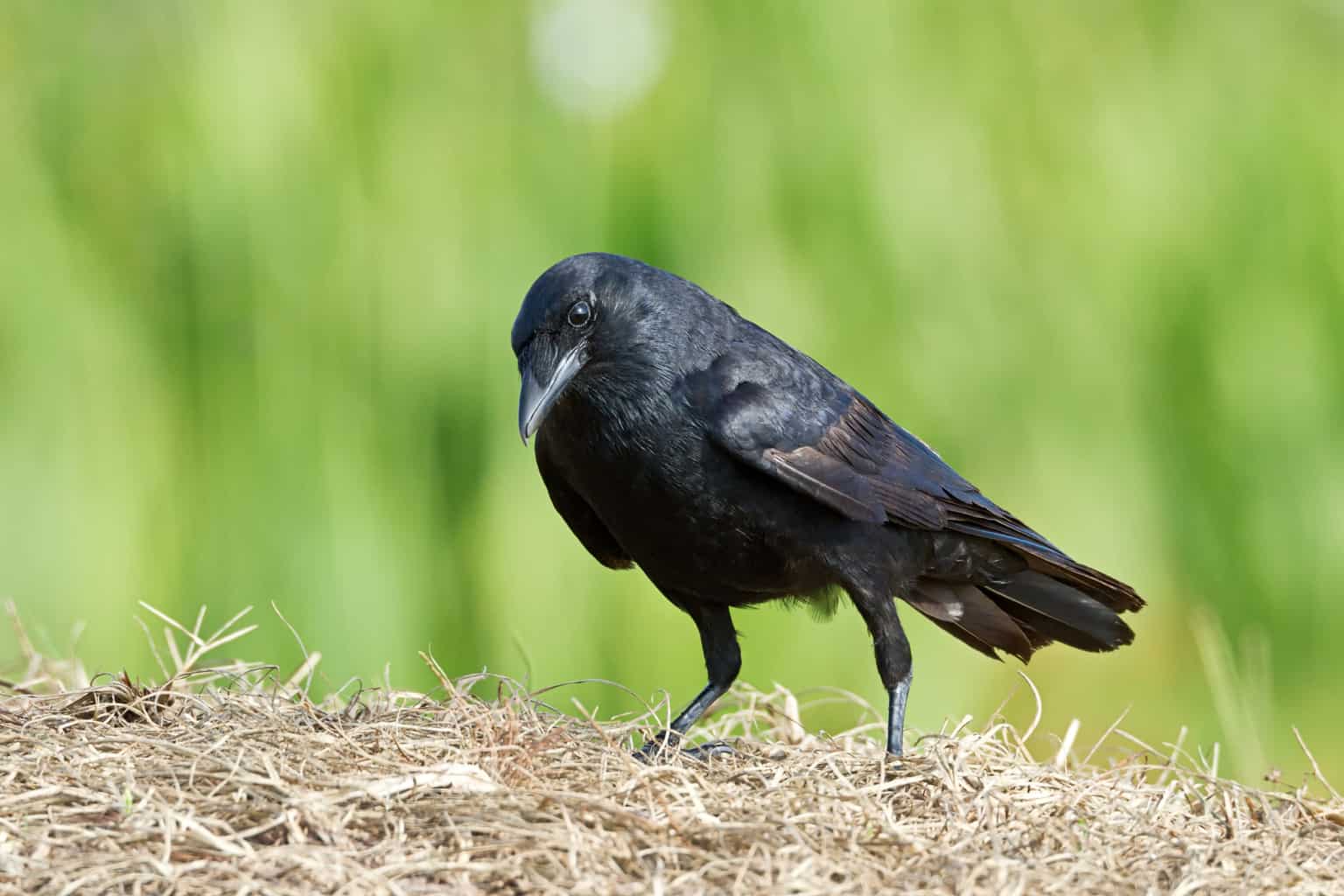
- Scientific Name: Corvus ossifragus
- Length: 10 – 17 in
- Weight: 9 – 11 oz
- Wingspan: 30 – 40 in
Additional Information:
The Fish Crow’s flight pattern is slow and steady. Its stiff wings and fan-shaped tail allow it to glide and hover when foraging.
These medium-sized birds have black plumage and dark bills. Males and females have the same coloring.
Fish Crows are similar to American Crows, yet the latter has larger upper parts and a more distinct call.
Brown Birds
Rock Wren

- Scientific Name: Salpinctes obsoletus
- Length: 5 – 9 in
- Weight: 0.5 – 1 oz
- Wingspan: 8 – 10 in
Additional Information:
The Rock Wren has been documented in Kentucky, but only very rarely. This bird is a weak flier and prefers foraging for food around rocks, which is how it got its name.
These small, popular birds are sexually monomorphic. They both have brown rumps and white-speckled brown upper parts.
Their flanks and bellies are a light shade of yellow. You can easily identify them by their long, barred tails with whitish tips.
Say’s Phoebe

- Scientific Name: Sayornis saya
- Length: 6 – 9 in
- Weight: 0.5 – 1 oz
- Wingspan: 11 – 13 in
Additional Information:
Say’s Phoebe are graceful birds with a buoyant flight pattern. They hover, then quickly dip to catch their prey, including insects, berries, and seeds.
You can spot these migratory birds in Kentucky during the summer. They prefer open areas, such as farmlands, prairies, and grass fields.
Males and females have dark grey-brown heads, foreheads, and napes. Their fan-shaped tails are a darker shade of brown color.
Grey Birds
Northern Shrike
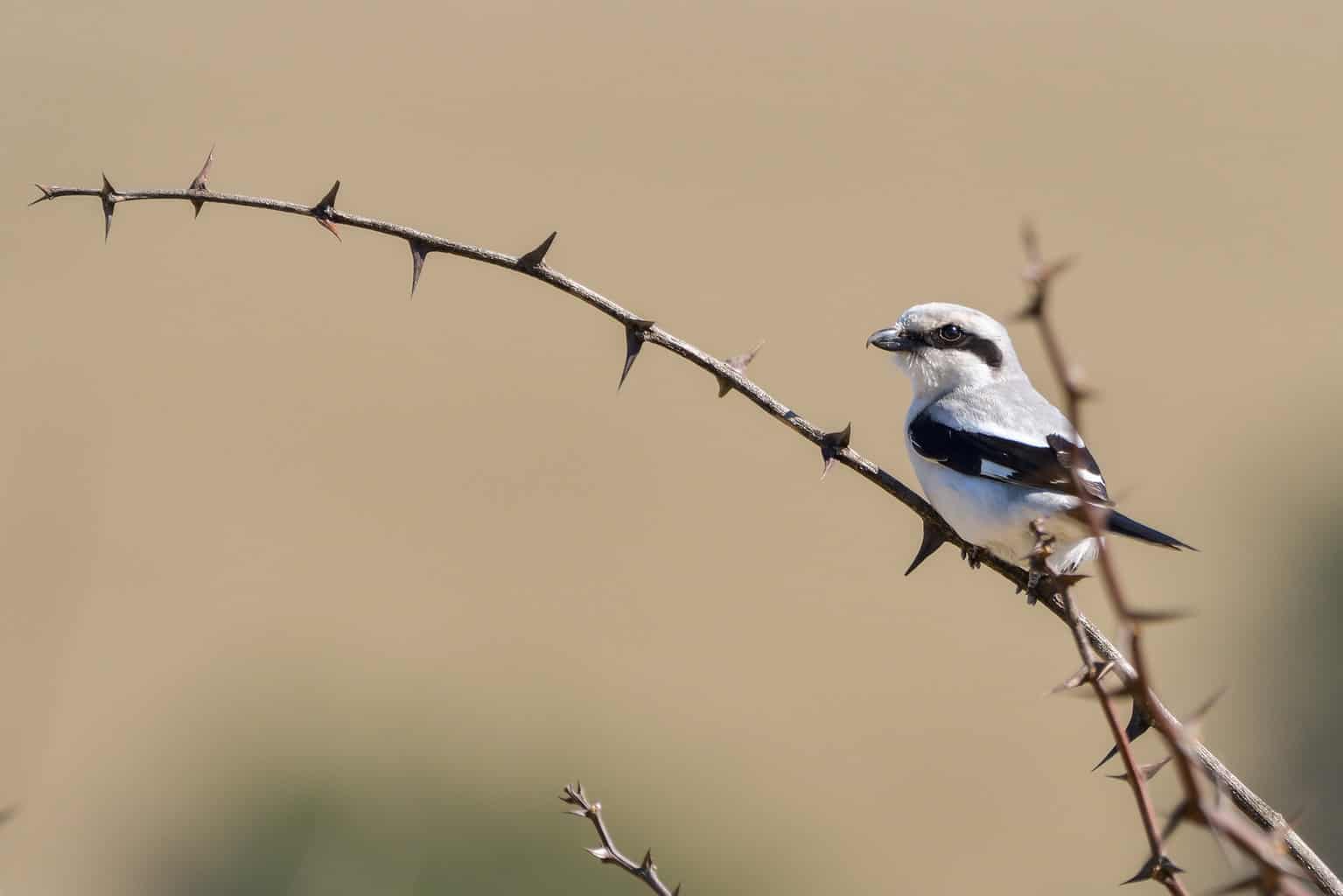
- Scientific Name: Lanius borealis
- Length: 5 – 10 in
- Weight: 1.5 – 2 oz
- Wingspan: 13.5 – 16.5 in
Additional Information:
The Northern Shrike is small and easy to identify. You can find it near forest edges, bogs, and open willow brushes.
The birds’ primary color is grey in various shades and hues. They have a black mask with a white border that looks like bushy eyebrows and give them a menacing look.
These medium-sized birds have long, dark tails with pale edges. Their bills are dark and thick, with a slight hook near the tip.
Ash-Throated Flycatcher
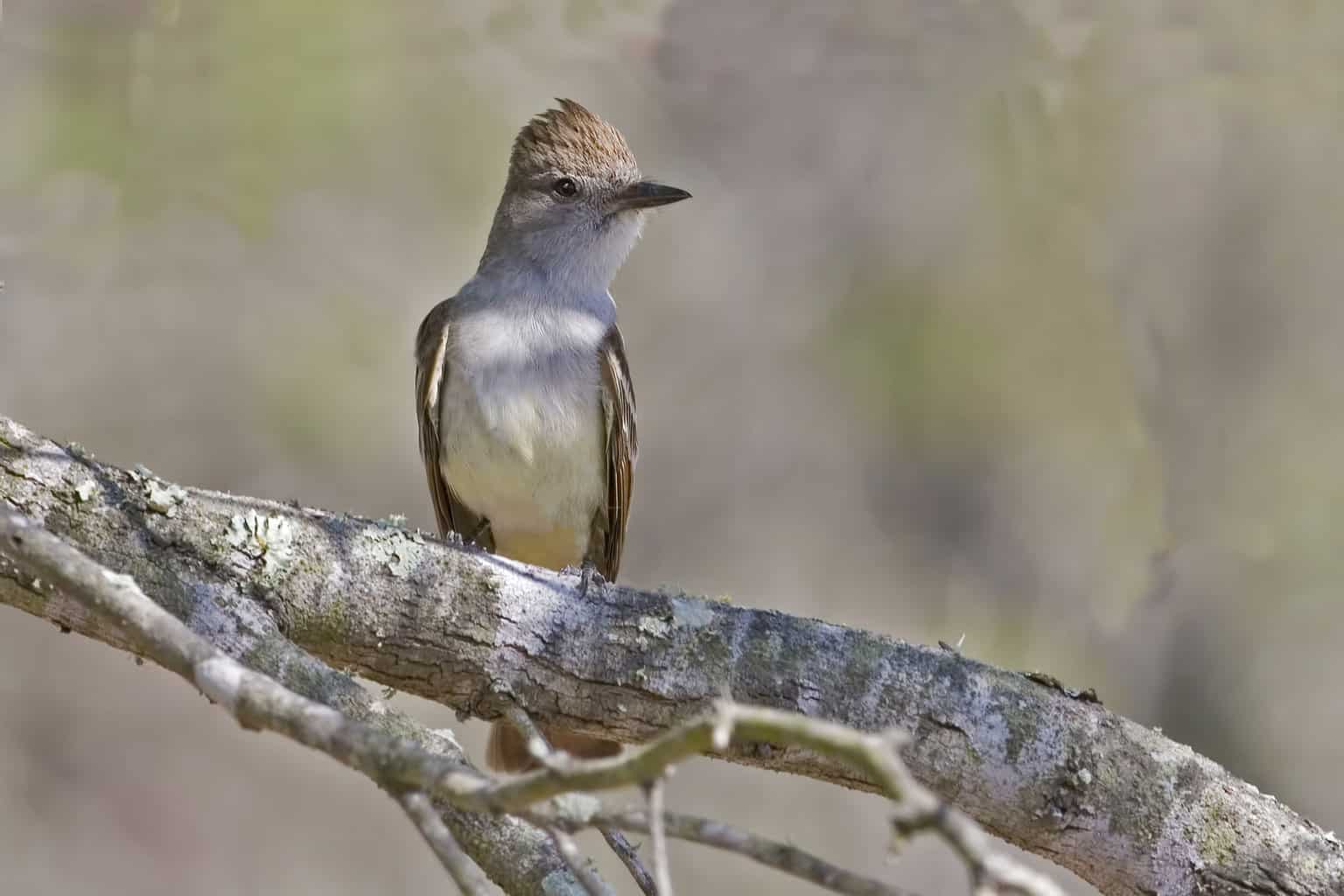
- Scientific Name: Myiarchus cinerascens
- Length: 7 – 9 in
- Weight: 0.5 – 1.5 oz
- Wingspan: 13 – 14 in
Additional Information:
Ash-throated Flycatchers feed on insects by capturing them in flight. They also eat fruits, beets, and small lizards.
Females and males have grey upper parts with light shades of grey on their chests and throats. Their tails are a deeper tinge of grey with tinges of rust-colored highlights.
You can identify them by their light yellow bellies. It differentiates them from other Flycatchers, such as the Myiarchus and the Nutting’s Flycatchers.
Purple Birds
Purple Martins
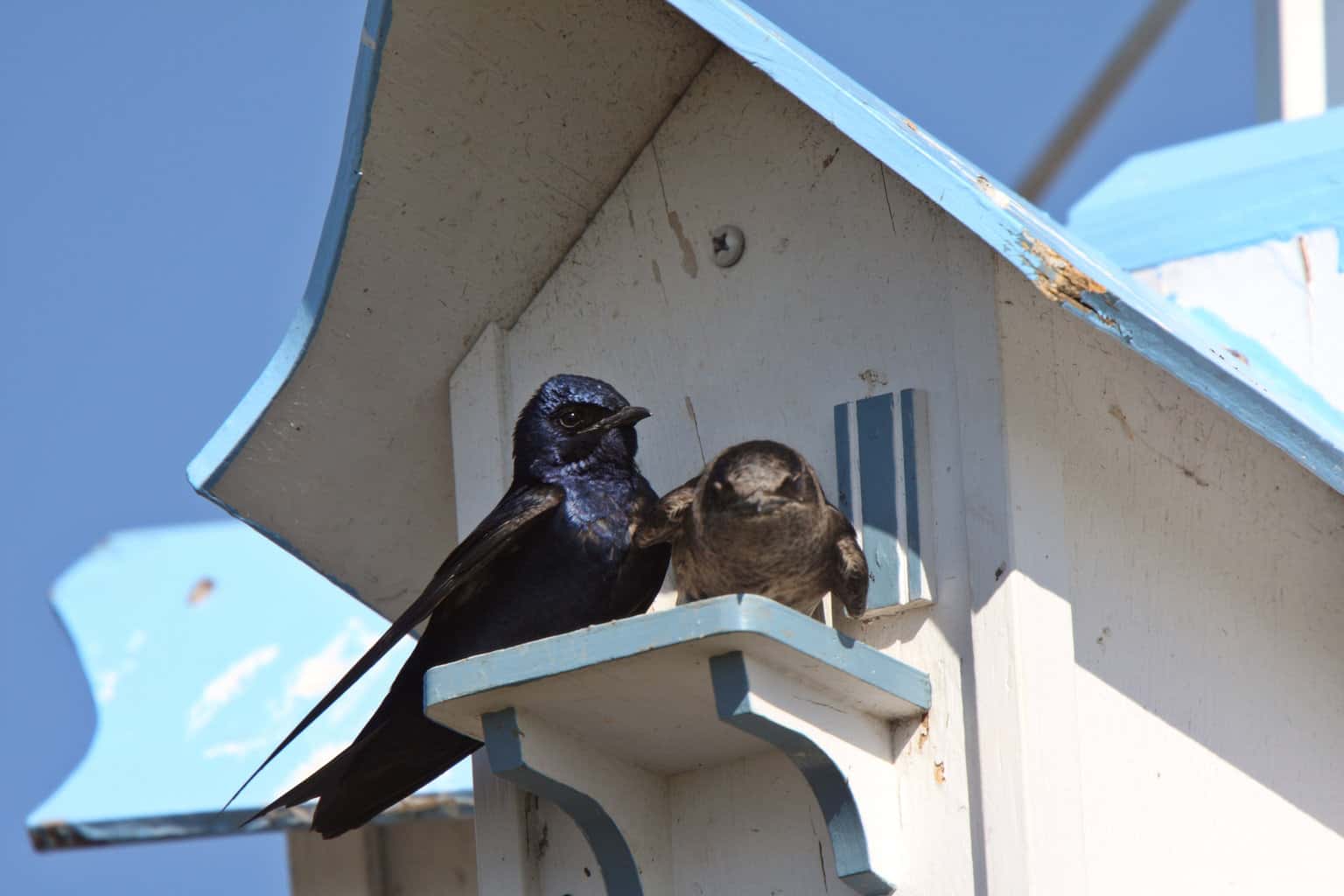
- Scientific Name: Progne subis
- Length: 7 – 8.5 in
- Weight: 1 – 2 oz
- Wingspan: 15.5 – 17 in
Additional Information:
Purple Martins belong to the swallow family. These large swallows can be found in residential areas, agricultural lands, and forest edges.
They can catch insects in mid-flight. They also forage on the ground for berries and seeds.
Their plumage is mainly a deep shade of glossy purple-blue. They have an iridescent sheen caused by light refracting on the barbules of each feather.
Purple Finch
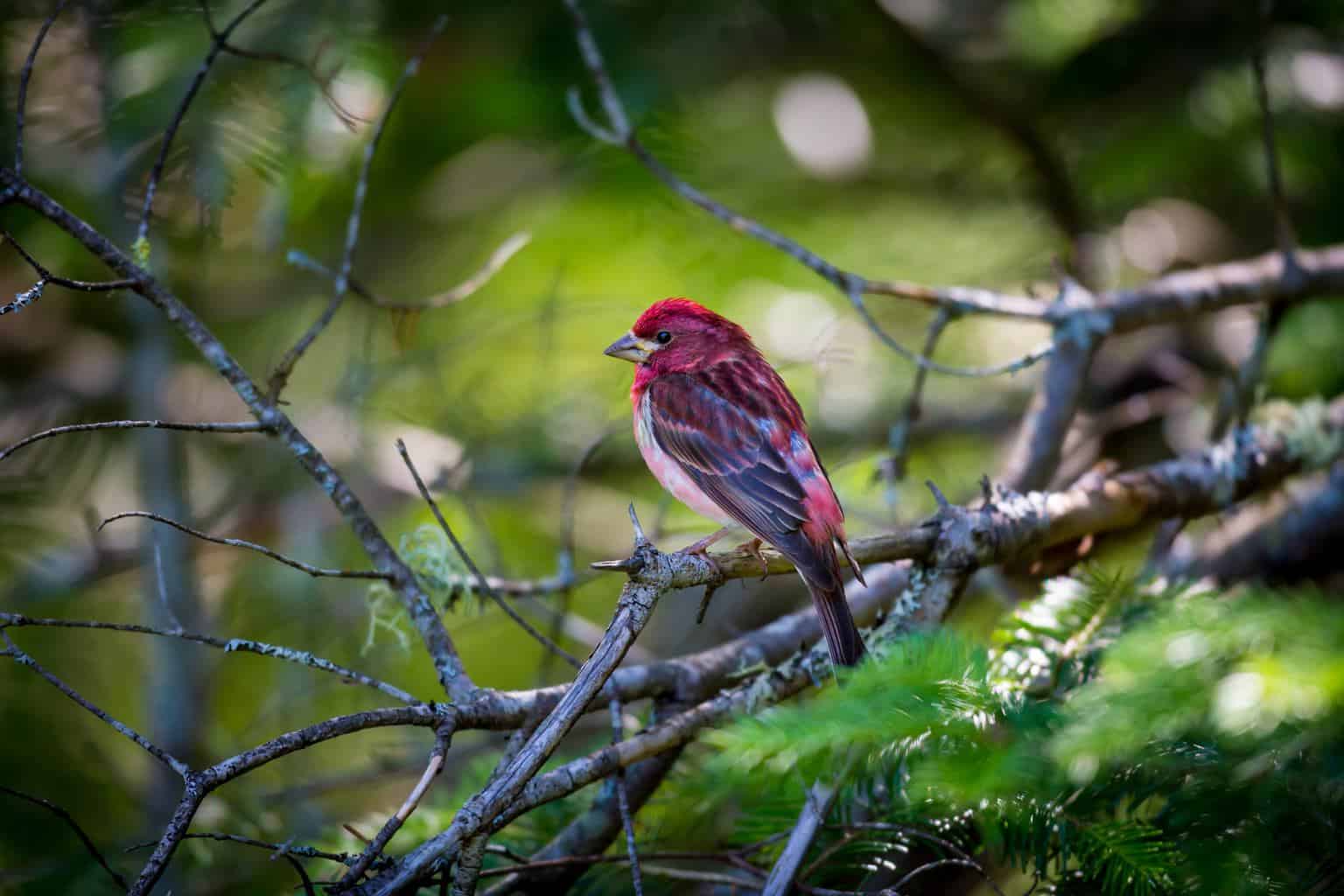
- Scientific Name: Haemorhous purpureus
- Length: 5 – 6 in
- Weight: 1 – 1.5 oz
- Wingspan: 9 – 10.5 in
Additional Information:
Purple Finches like to forage for nuts and berries in high coniferous trees and on the ground. They’ve also been known to visit bird feeders as long as there’s a fresh supply of seeds.
Male Purple Finches are actually deep red with brown streaks on their backs and napes. When sunlight shines on their heads, the rose-red color looks more purple than red.
Females have more brown plumage than red. They’re easy to tell apart from the males because of their white eyebrows and dark whiskers.
White Birds
Gull-Billed Tern
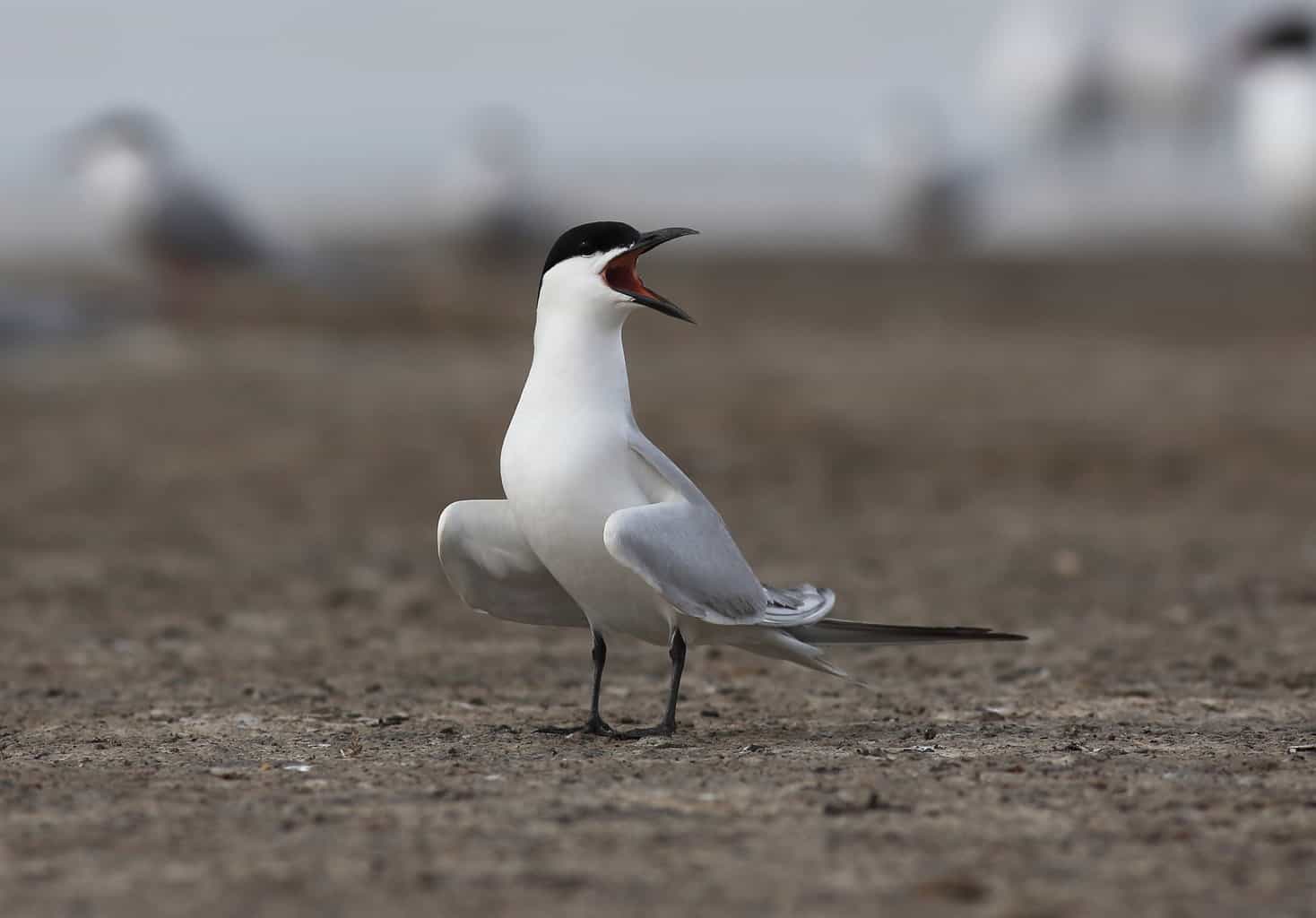
- Scientific Name: Gelochelidon nilotica
- Length: 12 – 14 in
- Weight: 7.5 – 8.5 oz
- Wingspan: 33 – 34 in
Additional Information:
Gull-billed Terns are the lightest of all North American terns. They prefer setting up their twig nest in sandy or grassy areas near bodies of water.
Their diet consists of small fish and crustaceans. They also feed on earthworms and frogs.
These graceful flyers have black caps, bills, and legs. The rest of their bodies are covered in white and pale grey plumage.
White Ibis

- Scientific Name: Eudocimus albus
- Length: 21 – 27 in
- Weight: 35 – 37 oz
- Wingspan: 21 – 27 in
Additional Information:
The White Ibis is the coastal version of this species. Their preferred habitat includes swamps, mangroves, and salt marshes.
They’re white all over with pink bills and legs that turn into a deep shade of scarlet during the breeding season. They also have a broad pink mask around the eyes and bills.
Their wings are entirely white except for some black on their undersides. These dark primary flight feathers appear only when the White Ibis is soaring overhead.
Conclusion
You’ve just seen a glimpse of some of the most colorful birds in Kentucky. From the small to the large, it’s hard not to be drawn in by these amazing creatures.
So, the next time you’re exploring the Bluegrass State, keep our guide handy. It’ll help you identify each type of bird by color, size, and even habitat.
Seeing these birds up close will give all inquisitive bird watchers a newfound appreciation for nature and all its inhabitants.

